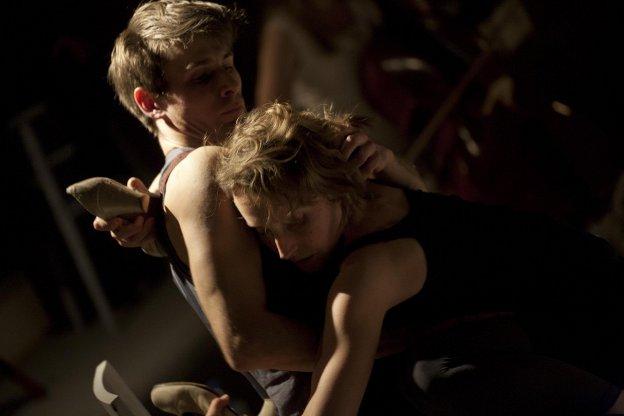The audience is seated in traverse, on either side of the stage area. The performers are in the space – sitting, waiting – and a metronome is ticking loudly. The lights go out, and we are plunged into total darkness. The velvet softness of the dark is shattered by the harsh sound of glass breaking.
The lights come up to show a barefoot girl walking on a narrow slither of a path of shimmering shards of glass. There’s cello, accordion, drum; there’s Erik Satie played on the piano. And then there is voice! Polyphonic Corsican choral singing, woven through with Bulgarian, Chechen, Romanian and Icelandic songs – the live music and choral work combining with the intense physical performance to make for a full-blooded and visceral work. There are ten performers onstage, seven musicians and three physical actors/dancers, one male and two female. Yet there are no real divisions – all is physical, and all is resonant voice. There is a stamping dance that kicks into cackles, then everything slips and cascades into another confrontation. There is musical saw, clapping, a dance like a mating ritual, an embrace that produces a squirt of blood that splatters onto the floor, a knife plunged repeatedly into a wooden table top.
Caesarean Section – Essays on Suicide is a word-free piece about suicidal compulsion and the involuntary force that pulls us back from the brink, delving into deep dark places and questioning whether life is or is not worth living. At times you just want to close your eyes and feel the reverberations. It’s a show that charges through your very being.
There is a memorable scene of an older woman attempting to reach up towards the light, climbing towards the light and falling, and trying and failing and trying again. Voices rise to echo her ascension. She doesn’t make it, and lies broken between the upturned chair legs. This goes into a sequence with darkly funny skits on suicide: attempting to drown in a bath; having a go at gnawing at one’s wrists. A silent woman holds a watering can, a noose attaching her to a baby tree. All this to the accompaniment of silent film wonky piano music.
The leg of a chair is dragged through a stream of broken glass. The vocal performers are at this point so physical with their voices, they are almost singing through their arms, their fingertips. We are bathed in lamentation. The passionately raw movement comes across as wildly reckless – so close to the glass we can hardly look. We wince and almost don’t want to witness potent images of near self-destruction and self salvation, yet at the same time don’t want to look away.
We don’t leave depressed, yet rather coursed through with a sense of potency, of mortality, and of the vibrancy of life and human spirit. An extraordinarily potent work.


